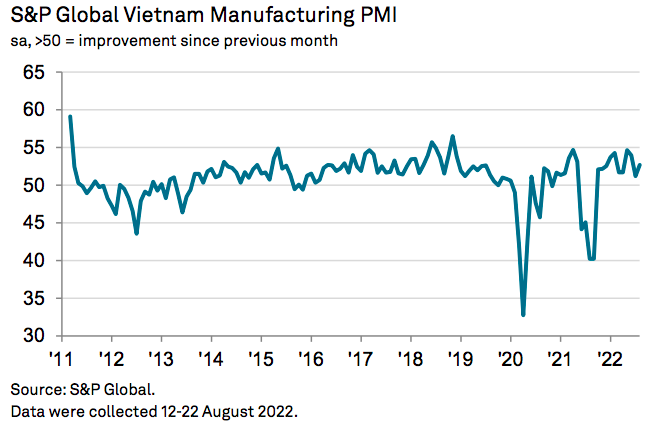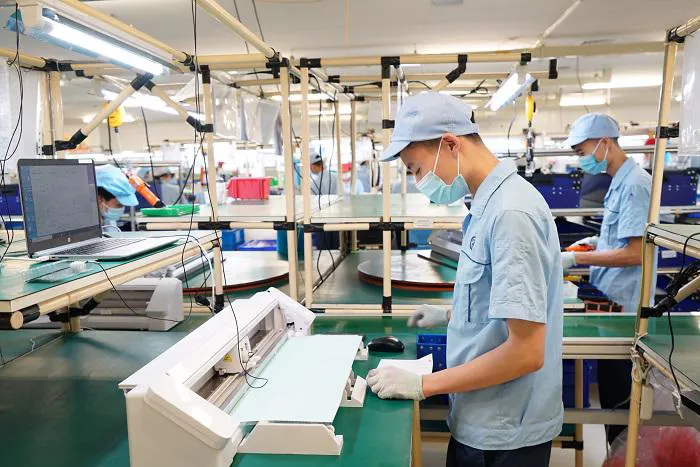Vietnam's manufacturing sector strengthens growth momentum in August
Business sentiment continues to improve with 57% of respondents predicting that output will increase over the coming 12 months, against 9% that expected a decrease.
Vietnam's Manufacturing Purchasing Managers' Index (PMI) posted 52.7 in August, up from 51.2 in July and signaling a solid improvement in the health of the manufacturing sector midway through the third quarter of the year.
In addition, business conditions have now strengthened in 11 consecutive months, according to S&P Global
A reading below the 50 neutral marks indicates no change from the previous month or even contractions, and above 50 points means an expansion.
“Growth momentum strengthened across the Vietnamese manufacturing sector during August as the latest PMI survey pointed to a lessening of some of the headwinds that firms have had to deal with in recent years,” said Andrew Harker, economics director at S&P Global.
"The most eye-catching development in August was a further sharp slowdown in input cost inflation, with costs only rising marginally in the latest survey period. This gave firms some breathing room to limit their price rises, thus boosting demand. Manufacturers also benefitted from the first shortening of suppliers' delivery times since November 2019, a marked turnaround from the widespread delays seen this time last year.
| Electronics production at Rhythm Precision Vietnam at Noi Bai Industrial Park, Hanoi. Photo: Pham Hung/ The Hanoi Times |
With these supply headwinds having dissipated, firms should be able to concentrate on securing greater new orders and expanding production over the remainder of 2022," he added.
According to S&P’s monthly PMI report, production growth regained momentum in August, after having slowed in July. The fifth successive rise in output was solid as firms reported a continued recovery from the Covid-19 pandemic and greater new orders.
Manufacturers reported higher new orders from both domestic and export customers. In line with the picture for output, the rise in total new orders was solid and sharper than seen in July. Panelists indicated that increased customer numbers, improving demand and competitive pricing was all behind the latest expansion.
Firms were helped in their efforts to price competitively by waning cost pressures. The rate of input price inflation slowed sharply for the second month in a row and was the weakest in 27 months of rising costs. In turn, firms also increased their selling prices at a softer pace, and one that was only marginal. Respondents mentioned lower costs for oil and other raw materials, although some firms continued to report rising transportation costs.
Rising new orders encouraged manufacturers to expand their staffing levels again in August. As was the case with output and new orders, the rate of job creation quickened midway through the third quarter.
A further increase in employment was partly behind the second reduction in backlogs of work in the past three months. The decline in outstanding business was the most pronounced in just over a year.
Firms also responded to higher output requirements by expanding purchasing activity, the eleventh consecutive month in which this has been the case.
Efforts to secure inputs were helped by the first shortening of suppliers' delivery times since November 2019 as an improving supply of raw materials enabled vendors to speed up deliveries. Despite rising purchasing activity and quicker deliveries from suppliers, stocks of purchases continued to fall as inputs were used to support the growth of production. Stocks of finished goods were also down as products were dispatched to customers.
Expectations that market conditions will be relatively stable over the coming year and that customer demand will improve supported confidence in the year-ahead outlook for production. Sentiment improved from that seen in July and was above the series average. Around 57% of respondents predicted that output will increase over the coming 12 months, against 9% that expected a decrease.
Hanoi’s industrial production activities continue its recovery process. The city’s index of industrial production in August expanded by 0.9% month-on-month and d15.7% year-on-year. Of which, the manufacturing and processing sector expanded by 16.8% year-on-year; electricity production and distribution by 6.4%; water provision and waste treatment by 9%; mining operation by 18.1%. For the eight months, Hanoi’s IIP expanded by 8.3% year-on-year, higher than the 6.3% rate recorded in the same period last year, in which the manufacturing sector went up by 8.6%; electricity production and distribution by 4.7%; water provision and waste treatment of 8%; and mining down by 3%. |











